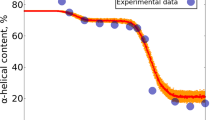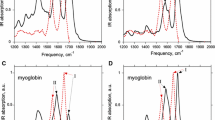Abstract
The distance geometry approach for computing the tertiary structure of globular proteins emphasized in this series of papers (Goelet al., J. theor. Biol. 99, 705–757, 1982) is developed further. This development includes incorporation of some secondary structure information—the location of alpha helices in the primary sequence—in the algorithm to compute the tertiary structure of alpha helical globular proteins. An algorithm is developed which estimates the interresidue distances between chain-proximate helices. These distances, in conjunction with the global statistical average distances obtainable from a database of real proteins and determined by the primary sequence of the protein under study, are used to determine the tertiary structure. Five proteins, parvalbumin, hemerythrin, human hemoglobin, lamprey hemoglobin, and sperm whale myoglobin, are investigated. The root mean square (RMS) errors between the calculated structures and those determined by X-ray diffraction range from 4.78 to 7.56 Å. These RMSs are 0.21–2.76 Å lower than those estimated without the secondary structure information. Contact maps and three-dimensional backbone representations also show considerable improvements with the introduction of secondary structure information.
Similar content being viewed by others
Literature
Creighton, T. E. 1983. “An Empirical Approach to Protein Conformation Stability and Flexibility.”Biopolymers 22, 49–58.
Finkelstein, A. V. and O. B. Ptitsyn. 1977. “Theory of Protein Molecule Self-organisation. I. Thermodynamic Parameters of Local Secondary Structures in the Unfolded Protein Chain.”Biopolymers 16, 469–495.
Goel, N. S., B. Rouyanian and M. Sanati. 1982. “On the Computation of the Tertiary Structure of Globular Proteins. III. Interresidue Distance and Computed Structures.”J. theor. Biol. 99, 705–757.
Goel, N. S. and R. L. Thompson. 1985. “Organization of Biological Systems—Some Principles and Models.”Int. Rev. Cyto. (in press).
Havel, T., I. D. Kuntz and G. M. Crippen. 1983. “Theory and Practice of Distance Geometry.”Bull. math. Biol. 45, 665–720.
—, and K. Wüthrich. 1984. “A Distance Geometry Program for Determining the Structures of Small Proteins and Other Macromolecules for Nuclear Magnetic Resonance Measurements of Intramolecular1H−1H Proximities in Solution.”Bull. math. Biol. 46, 673–698.
Levitt, M. and J. Greer. 1977. Automatic Identification of Secondary Structure in Globular Proteins.”J. molec. Biol. 114, 181–293.
Ptitsyn, O. B. and A. A. Rashin. 1975. “A Model of Myoglobin Self-organization.”Biophys. Chem. 3, 1–20.
Schulz, G. E. and R. H. Schirmer. 1979.Principles of Protein Structure. New York: Springer-Verlag.
Wako, H. and H. A. Scheraga. 1982. “Distance-constraint Approach to Protein Folding. II. Prediction of Three-dimensional Structure of Bovine Pancreatic Trypsin Inhibitor.”J. Protein Chem. 1, 85–117.
Author information
Authors and Affiliations
Rights and permissions
About this article
Cite this article
Cariani, P., Goel, N.S. On the computation of the tertiary structure of globular proteins—IV. Use of secondary structure information. Bltn Mathcal Biology 47, 367–407 (1985). https://doi.org/10.1007/BF02459922
Received:
Issue Date:
DOI: https://doi.org/10.1007/BF02459922




